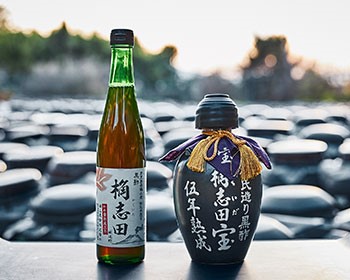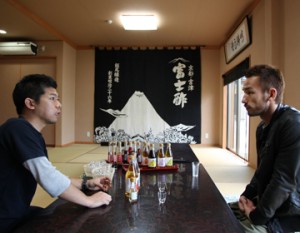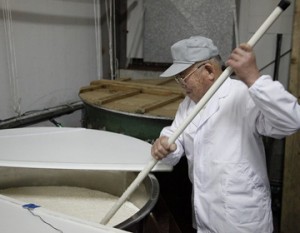In front of you are more than 20,000 aman jars, or tortoiseshell pots. In this region, the place where these jars are lined up is called a “field. The black vinegar grows in the sunlight, wind, rain, and sometimes volcanic ash. Fukuyama, Kirishima City, Kagoshima Prefecture, is a town of black vinegar. There are eight vinegar breweries that ship black vinegar all over Japan.
There have been studies on why Fukuyama produces such high quality black vinegar, but they have not been able to fully explain it. I heard that they once made the same vinegar in the same way using the same ingredients, but it didn’t work,” said Shinji Kubozono, factory manager of Fukuyama Kurozu.

The History of Vinegar
It is said that vinegar was first produced in Babylonia in southern Mesopotamia (around present-day Iraq) about 7,000 years ago, in 5000 BC. Later, the manufacturing method spread throughout the world, and vinegar made from various ingredients such as barley and cereals was born and handed down from generation to generation.
Vinegar production began in this area around 1800 during the late Edo period. The fine rice grown here, clean spring water from the Shirasu Plateau, and a climate with cool summers and mild winters were the perfect environment for vinegar making. 200 years have passed, and the method of making vinegar has not changed.
The “Black Vinegar Making Process” remains unchanged to this day.
What differentiates black vinegar from ordinary black vinegar is the jar used and its fermentation period. Ordinary black vinegar is fermented and matured for six months to a year. However, the black vinegar handled by Fukuyama Black Vinegar is aged for at least three years, and in the longest cases for as long as 10 years. The traditional pot brewing method using an aman jar is what maximizes the effects of this issuance period. These aman jars absorb solar heat and regulate convection and temperature, making them suitable for outdoor fermentation. The more the aman jar is used, the more natural yeast and acetic acid bacteria adhere to it and the better the jar becomes, producing the one and only black vinegar.

Black vinegar, renowned as a health food, and its benefits
Increasingly, television programs and magazine features are introducing the health benefits of consuming “fermented foods. Recently, supplements combining black vinegar, a fermented food, and garlic have become well-known. The benefits that can be expected from black vinegar itself include the suppression of elevated blood sugar levels and improvement of fatigue. Since ancient times, fermenting food has been used as a preservative food in times when refrigerators were not available, because fermenting food makes it more preservative. A few years ago, “shio koji recipe” was popular because it was said to bring out the original flavor of food by producing amino acids and sugars through fermentation. Furthermore, since fermented food helps the intestines digest and boosts the immune system, the popularity of fermentation-themed restaurants is increasing, especially among health-conscious people.
When we think of fermented foods, we probably think of soy sauce, miso, natto (fermented soybeans), and so on. Cheese, pickles, dried bonito flakes are also fermented foods, as are sake, black tea, oolong tea, etc. In fact, Japanese people eat many fermented foods on a daily basis. In fact, Japanese people eat many fermented foods on a daily basis. Because they are familiar foods, there must be many people who want to choose the best ones.
In addition to the pot farm, Kakuida operates an exhibition corner, a gallery, and Japan’s first black vinegar restaurant. At the restaurant, visitors can enjoy a limited-edition lunch where all dishes are made with black vinegar from Kakuida and original black vinegar drinks, and at the store, brown rice black vinegar “Kakuida” and popular black vinegar dressings commercialized from the flavors of the restaurant are available for purchase.
Fukuyama Kurozu’s products are characterized by a taste and aroma with little of the irritation characteristic of vinegar. The taste overturns the common notion that black vinegar is good for one’s health but is difficult to drink. It is interesting that a product created by history has become a black vinegar with a taste that is both healthy and tasty, both of which are necessary in today’s society.

<LEFT>Organic Kakuida Takara
The ultimate black vinegar, made with the utmost care and attention to ingredients and traditional methods, slowly fermented and matured in a jar over a period of five years and a lot of time and effort.
<RIGHT>Organic Kakuida Takara, aged for 5 years
This is the excellent brown rice black vinegar from “Kakuida,” which is made from raw materials and using the best production methods. It is named “Treasure” in honor of the master brewer who has carefully nurtured it for more than 1,800 days as if protecting a treasure.
Extensive lineup of seasonings
The “Raw Fruit Black Vinegar” is made from three-year aged organic black vinegar, and is made by soaking fresh, whole fruits in it. It is recommended for those who do not like sourness, as it has the original aroma and flavor of juicy fruits and the charm of black vinegar. As seasonings, the “Sanpai Kurozu” (black vinegar with three cups), which does not contain any chemical seasonings, and the “Katsuobushi no Kurozu Ponzu” (black vinegar ponzu with bonito flakes), which uses plenty of bonito flakes from Makurazaki, Kagoshima, can be used in hot pots and is a useful product in the home.







